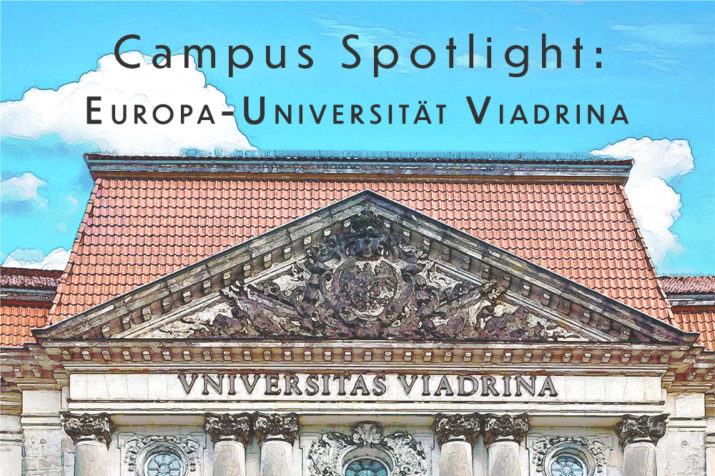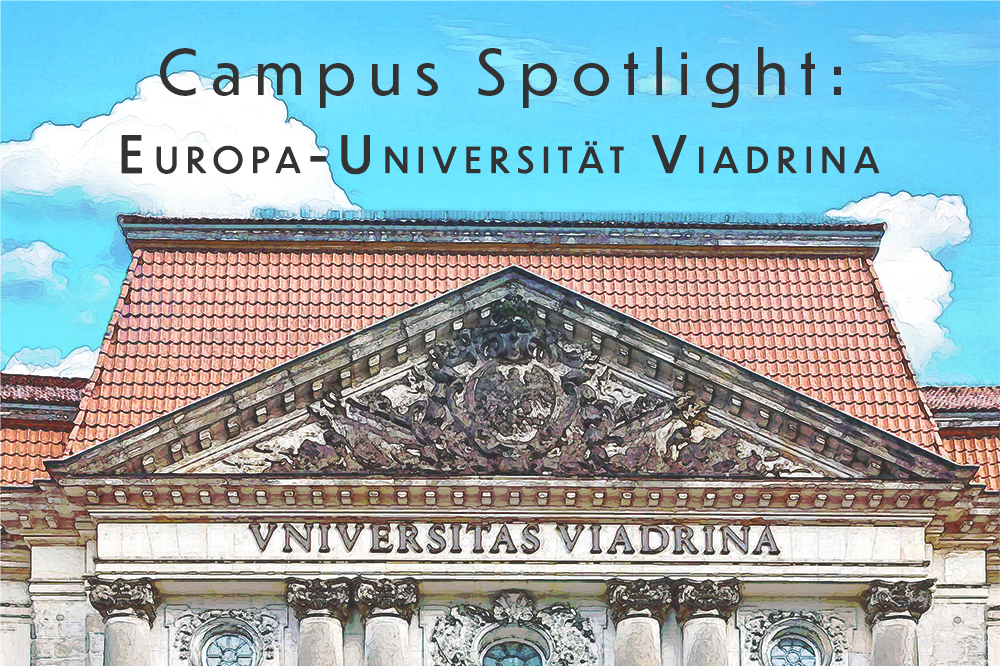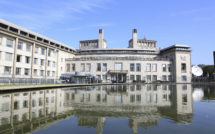

This is part of our special feature, Imagining, Thinking, and Teaching Europe.
A spotlight on the Europa-Universität Viadrina.
A few minutes’ walk from the shores of the Oder River—the fluvial border between Germany and Poland—stands the Europa-Universität Viadrina (“the Viadrina”) in Frankfurt an der Oder, a town with a prestigious past as a major commercial port 80 kilometers east of Berlin and downstream from the Neisse-Oder confluence on the way to the Baltic Sea. As we ponder in this issue of EuropeNow about the state of and various in-roads into European Studies, the Viadrina offers one institutional proposition about how “Europe” can be not only apprehended intellectually, but also envisaged through educational and research collaborations. One favorite adage of geographers is that “place matters.” This maxim could not reflect any better the ways in which the German town of Frankfurt an der Oder―coined the German “Gateway to the East”―and its Polish counterpart and “double,” Słubice, on the opposite side of the Oder, have woven ties at the German-Polish border through concerted educational goals embodied in the Collegium Polonicum. The latter results from a cross-border binational institutional partnership bringing together the Viadrina and Adam Mickiewicz University and constitutes an explicit manifestation of a “Słubfurt” shared cultural space.[1]
Nowhere can the idea of Europe be better tested than at a historical geopolitical border, which until 2007, materialized an eastern limit to the EU Schengen Area. It is indeed easy to notice that the notion of borderland is omnipresent in the ways in which scholars, students, and administrators at the Viadrina question themselves, their work, their institution, and what they can bring to international collaboration efforts through participation in pedagogical programming and research cooperation ventures. The border there is not a mere line that used to (or may still, to some extent) separate two worlds. Instead, as it has slowly dissolved, the border has become a place that unites people and where joint projects come about fruitfully, often fostered by the state of Brandenburg. The common history of these two border towns reveals that Viadrina’s students have been instrumental in operating a rapprochement between the two sides of the Oder as soon as Poland joined the EU. Students are often those carrying out in practice the university’s mission for promoting cultural exchanges, not only within the Słubfurt sub-culture, but between Germany and Poland in general, as well as with other places in Europe, as they thrive on a rich transborder and multi-lingual curriculum and participate in the forging of a youth transborder identity.
In this Spotlight, EuropeNow has gathered a group of institutional representatives with various positions at the university so they can explain some fundamental aspects and programs in operation at the Viadrina. To start, Estela Schindel and Timm Beichelt provide an overview of the Viadrina across time, from its early beginnings in the sixteenth century as the Universitas Francofurtensis to its rebirth and cooperation with Adam Mickiewicz University after the fall of the Berlin wall, and finally to the founding of the Viadrina Institute for European Studies, which critically explores Europeanization, and in particular border-making. Seeking to define the Institute’s “critical” approach to European-focused research, Schindel and Beichelt describe how research and teaching are particularly attentive to “European social orders and power relations,” thus allowing “deficits and conflicts in the European project” to come to light. In order to illustrate how this mission is implemented programmatically, Kerstin Hinrichsen introduces Viadrina’s Master in European Studies as an example of how this critical approach permeates the curriculum and its various components. Based on the three pillars of internationality, interdisciplinarity, and criticality, the MA program attracts students from Eastern or Western Europe who benefit from multiple relationships with other universities in Europe. Concentrating on the reach of the academic ties that the Viadrina has been able to weave into its varied programming options, Elsa Tulmets brings notice in her contribution to one specific tri-partite endeavor between the Viadrina, Université Paris 1 Panthéon-Sorbonne, and the Franco-German research Centre Marc Bloch in Berlin. Launched in 2008, Pensées françaises contemporaines is a Franco-German program that strives on scholarly exchanges and crosspollination through a system of mutual visiting professorships across the social sciences and humanities, soon expanding to digital studies as the Viadrina prepares for a future where the digital is not only a necessity, but also a conduit for furthering collaborative opportunities. Finally, Clara Frysztacka shares with EuropeNow’s readers two exciting syllabi that demonstrate the breadth and depth of her teaching in the Bachelor’s curriculum with her course on The “European Idea:” Historical Contexts, Debates, and Mental Maps on Europe as a Concept and in the Master’s track with her seminar on Europe: Imperial, Colonial, Transnational? An Introduction to Modern European History. Both courses contribute an exploration into “Europe” as a cultural and political construct always in the making and continuously renewed, and engage students in a reflection on the nature of the nation-state, competing regional European imaginations, and the role of extra-European spatiality, focusing in particular on European imperial pasts and legacies. It is no wonder that the Viadrina, where all is organized to facilitate the development of multilingual and multi-cultural competencies and experiences, has been seen as the ideal platform to express ideas about Europe and the world and a stanch hope for European integration.[2]
-
Introduction by Hélène Ducros
-
“Europe at its Borders, Europe at its Heart: Critical European Studies at the Viadrina” by Estela Schindel and Timm Beichelt
-
“European Studies at European University Viadrina in Frankfurt (Oder): Critical, Interdisciplinary, and International” by Kerstin Hinrichsen
-
“Pensées Françaises Contemporaines: An Interdisciplinary Program Promoting French Approaches in the Social Sciences and Humanities” by Elsa Tulmets
-
“Syllabus: Europe: Imperial, Colonial, Transnational? An Introduction to Modern European History” by Clara Frysztacka
-
“Syllabus: The ‘European Idea:’ Historical Contexts, Debates, and Mental Maps on Europe as a Concept” by Clara Frysztacka
Hélène B. Ducros, JD, PhD, is Jean Monnet Chair of Research and Pedagogy at EuropeNow. Her research in human geography focuses on place-making and landscape change. She is committed to the comparative investigation of eduscapes and co-chairs the Critical European Studies Research Network at CES (follow on Twitter at @CESCritEuro).
References:
[1] Quentin Mackré, “Géopolitique de Francfort-Sur-l’Oder/Słubice, ville-doublon sur une frontière en deconstruction,” L’Espace Politique, 8, no. 2 (2009), online 15 November 2009, accessed 21 May 2020. URL : http://journals.openedition.org/espacepolitique/1348 ; DOI : https://doi.org/10.4000/espacepolitique.1348
[2] Gundula Gwenn Hiller, “Cultiver le dialogue interculturel à l’université européenne Viadrina de Francfort-sur-l’Oder, en Allemagne,” in Dialogue Interculturel sur les Campus Universitaires, eds. Sjur Bergan and Jean-Philippe Restoueix, Council of Europe, 11 (2009): 115.
Published on June 3, 2020.




